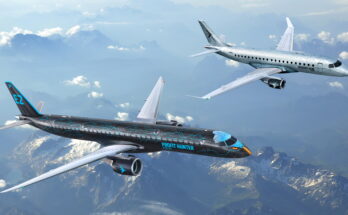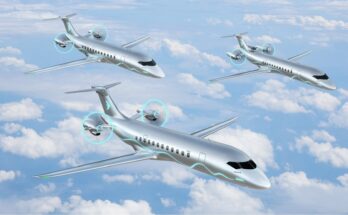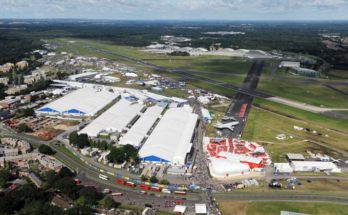Quiet Month at the Office /// Airbus Sets New Industry Backlog Record – Again


January is traditionally the slowest month of the year for commercial aircraft production, and January 2024 was no exception. Boeing delivered 27 commercial jets compared to Airbus with 30 units. This compares to 38 deliveries for Boeing and 20 for Airbus in January of last year. In 2023, in total, Boeing and Airbus delivered 528 and 735 aircraft compared to 480 and 663, respectively, in 2022. In 2023, Airbus won the deliveries crown for the fifth consecutive year.
Following a more than challenging 2020 due to the COVID-19 pandemic, 2021-23 were recovery years for the two largest commercial plane makers. Boeing still has quite a way to go before setting new all-time company deliveries records, whereas Airbus could be back to pre-pandemic levels already this year. In 2018, before COVID-19 and the first 737 MAX grounding, Boeing delivered 806 jets, a level that will likely not be recaptured before the 2025-26 timeframe. Airbus’ record high of 863 shipments was set in 2019, a level that could be narrowly surpassed in 2024 if the supply chain can keep up. Also, Airbus is expected to retain their deliveries lead for the foreseeable future due to the company’s comfortable backlog lead over its American rival. Before 2019, Boeing had out-delivered Airbus every year since 2012.
As indicated above, in January, Boeing delivered 27 jets, including 25 737s (all MAXs), one 767, and one 787. Since June of last year, the 737 program was producing aircraft at an official rate of 31 per month. At the end of 2023, the program completed the transition to 38 aircraft per month. At their Q4 earnings call, Boeing confirmed that the rate of 38 is now in effect. Boeing expects to increase production to approximately 50 737 MAX jets per month in the 2025/26 timeframe. The target of 50 per month compares to the pre-crash/pre-pandemic rate of 52 737s per month in 2018. Last year, it was reported that the company is planning to boost production to 52 jets per month by January 2025. Boeing will open a new 737 MAX production line in Everett in the second half of 2024. The new line is in addition to the three lines currently in place at Renton. For now, in the aftermath of the Alaska Airlines Flight 1282 incident, the program will remain at 38 aircraft per month, while Boeing works with regulators to resolve all outstanding quality issues with the 737 MAX. Boeing ended the year with 200 737 MAX jets in inventory, down 50 from Q3 2023. Boeing expects most of the inventoried jets to be delivered by the end of 2024. The company is still producing 737 NGs but now only has 16 737-800s remaining in backlog.
In August 2022, deliveries of the Boeing 787 Dreamliner were resumed following a suspension of shipments that lasted nearly 16 months. Boeing had suspended Dreamliner deliveries in May 2021 for the second time in less than a year. In January, the 787 production rate was raised to five per month, and more increases will follow until the program reaches the current target of 10 aircraft per month by 2025/26. Boeing ended the year with 60 Dreamliners in inventory, down 15 from Q3 2023.
The 767 program is currently producing jets at a rate of three units per month, a mix of KC-46 tankers (based on the 767-2C) and 767-300 freighters. The 777 program is currently pushing out aircraft at a rate of three per month. Most aircraft in backlog are 777 freighters, with only five 777-300ERs left. The 777 program was expected to get a new addition in late 2023 with the first delivery of the 777X, but in 2022, Boeing announced this will now not happen before 2025. Boeing will also launch a new 777X-based freighter, thereby expanding its 777X and cargo portfolio. By the 2025/26 timeframe, Boeing expects to be delivering four 777s per month.
In January, Airbus delivered 30 jets, including two A220s, 26 A320s (all NEO), and two A330s. The official A320 production rate is 45 aircraft per month and has remained at this level since the end of 2021. On average, the company delivered 48 A320s per month in 2023 compared to 43 in 2022. Production is currently being increased and an official rate hike is coming soon. In connection with the release of their 2023 full-year earnings this month, we can expect the A320 rate to be officially raised. At this time, we consider the unofficial A320 production rate to be 48 per month but will keep the rate in our charts and tables at 45 for now. The A320 program is expected to reach a monthly rate of 65 by late 2024. We can therefore expect a series of rate increases this year. Also, Airbus is working with its supply chain to increase A320 production to 75 aircraft per month in 2026.
The A220, meanwhile, is being produced at a rate of six aircraft per month, with a monthly production rate of 14 expected by 2025. We also expect Airbus to increase the official A220 rate soon. Airbus is currently considering to introduce a stretch version of the A220, which many now refer to as the “A220-500” or even “A221.” Currently, the Pratt & Whitney PW1500G is the only engine option for the A220, and the new variant will most likely come with a second engine option.
The A330 production rate was increased from two aircraft per month to three at the end of 2022, with an increase to four per month expected this year. The A350 production rate was raised to six per month at the end of 2023 in line with Airbus’ announcements. Airbus expects to produce nine A350s per month by 2025.
Turning to the January orders review, in terms of reported bookings, Boeing had a quiet month at the office. The company booked orders from undisclosed customers for a total of three 737 MAX jets (gross orders) and reported three cancellations (two 737 MAX and one 787), resulting in zero net new orders. On January 18, Boeing revealed the identity of the airline behind the large undisclosed 737 MAX order reported in December 2023. The airline is Indian low-cost carrier, Akasa Air, which placed a follow-on 737 MAX order for a total of 150 737-10s and 737-8-200 jets. The order was announced at the WINGS INDIA 2024 airshow, which took place in Hyderabad from 18-21 January. The aircraft will be added to Boeing’s orderbook at a later date. In 2023, Boeing booked a total of 1,314 net new orders (1,456 gross orders) – before ASC 606 changes – compared to 774 net new orders (935 gross orders) in 2022. Please note that for comparison reasons, we do not include Boeing’s so-called ASC 606 accounting adjustments in the numbers reported in this article and regard net new orders as gross orders minus cancellations.

In January, Airbus booked orders from two customers for a total of 31 jets (gross orders) and reported no cancellations. Delta Air Lines ordered 20 A350-1000s while Ethiopian Airlines secured 11 A350-900s. In 2023, Airbus won the orders crown for the fifth consecutive year booking an astounding 2,094 net new orders (2,319 gross orders), compared to 820 net new orders (1,078 gross orders) in 2022.
At the end of January, Airbus reported a new industry backlog record of 8,599 jets (+1 from old record), of which 7,769, or 90 percent, were A220 and A320ceo/neo family narrowbodies. Airbus’ old record was set in December 2023 when the company reported a backlog of 8,598 jets. By the end of last month, Boeing’s backlog (total unfilled orders before ASC 606 adjustment) was 6,189 aircraft (Boeing’s backlog record of 6,216 aircraft was set in December 2023), of which 4,775, or 77 percent, were 737 NG/MAX narrowbody jets. The number of Airbus aircraft to be built and delivered represents 10 years of shipments at the 2019 production level (the pre-pandemic level), or 11.7 years based on the 2023 total. In comparison, Boeing’s backlog would “only” last 7.7 years at the 2018 level (the most recent “normal” year for Boeing), or 11.8 years based on 2023 deliveries. Boeing’s book-to-bill ratio last year, calculated as net new orders divided by deliveries, was 2.49 with Airbus coming in even higher at 2.85. This means that both companies received well over two new firm orders for every aircraft delivered.
2024 Forecast
Forecast International’s Platinum Forecast System is a breakthrough in forecasting technology that provides 15-year production forecasts. The author has used the Platinum Forecast System to retrieve the latest delivery forecast data from the Civil Aircraft Forecast product. For 2024, Forecast International’s analysts currently expect Boeing and Airbus to deliver 608 and 852 commercial jets, respectively. Please note that these figures exclude militarized variants of commercial platforms such as Boeing’s P-8 Poseidon maritime patrol aircraft and KC-46 Pegasus tanker and Airbus’ A330 MRTT tanker.
In its current year guidance, Airbus is scaling up its aircraft production, hoping to deliver 800 planes in 2024, compared to 735 delivered the previous year. Meanwhile, Boeing decided to forgo issuing their 2024 production forecast as it focuses on safety improvements following the Alaska Airlines incident.
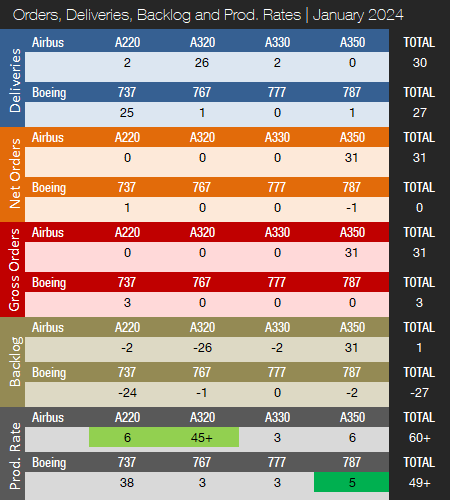
Note: Light green color for production rates means the program is currently transitioning to a higher rate. Green color means the rate has just been increased.
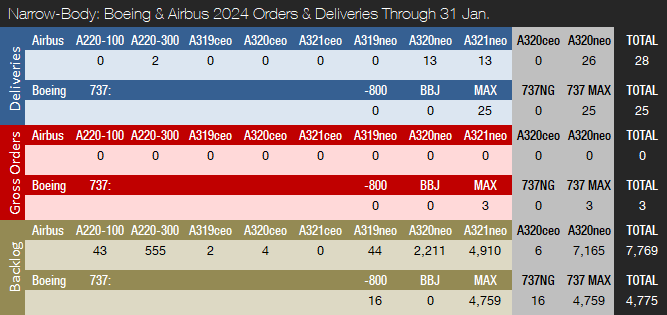


References:
- https://www.forecastinternational.com/platinum.cfm
- http://www.boeing.com/commercial/#/orders-deliveries
- https://www.airbus.com/aircraft/market/orders-deliveries.html
- https://boeing.mediaroom.com/2024-01-31-Boeing-Reports-Fourth-Quarter-Results
- https://s2.q4cdn.com/661678649/files/doc_financials/2023/q4/4Q23-Earnings-Call-Transcript.pdf
- https://boeing.mediaroom.com/2024-01-18-Akasa-Air-Orders-150-More-Boeing-737-MAX-Jets-For-Domestic-and-International-Expansion
- https://www.airbus.com/en/newsroom/press-releases/2024-01-delta-air-lines-orders-20-airbus-a350-1000-aircraft
- https://www.airbus.com/en/newsroom/press-releases/2024-02-airbus-reports-full-year-fy-2023-results
Kasper Oestergaard is an expert in aerospace & defense market intelligence, fuel efficiency in civil aviation, defense spending and defense programs. Mr. Oestergaard has a Master's Degree in Finance and International Business from the Aarhus School of Business - Aarhus University in Denmark. He has written four aerospace & defense market intelligence books as well as numerous articles and white papers about European aerospace & defense topics.

